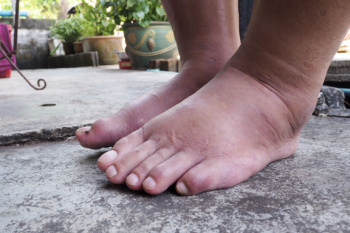
Connellsville


Having swollen feet, also known as foot edema, is a common issue that can occur for a variety of reasons. Simple causes include standing or sitting for long periods of time, especially in hot weather, which can lead to fluid retention. Minor injuries, such as sprains or strains, can also cause temporary swelling. However, persistent or severe swelling could signal more serious health conditions. Heart failure, kidney disease, and liver disorders can all cause fluid buildup in the lower extremities. Venous insufficiency, where the veins struggle to return blood to the heart, is another possible cause. Blood clots in the legs or infections can also trigger swelling. Treatment depends on the underlying cause. For mild cases, elevating the feet and reducing salt intake may help. If you have swollen feet from an unknown cause and especially if accompanied by pain, shortness of breath, or other symptoms, it is suggested that you contact a podiatrist promptly for an evaluation and care.
Swollen feet can be a sign of an underlying condition. If you have any concerns, contact Dr. Arnold Tarpley, Jr. of Tarpley Foot and Ankle Center. Dr. Tarpley can provide the care you need to keep you pain-free and on your feet.
Swollen feet are a common ailment among pregnant women and people who stand or sit for extended periods. Aging may increase the possibility of swollen feet and patients who are obese often notice when their feet are swelling too. There may be medical reasons why swollen feet occur:
Swollen feet can also be caused by bone and tendon conditions, including fractures, arthritis, and tendinitis. Additionally, there may be skin and toenail conditions and an infection may cause the feet to swell. Patients who take medicine to treat high blood pressure may be prone to getting swollen feet.
Many patients elevate their feet to help relieve the swelling and this is generally a temporary remedy. When a podiatrist is consulted the reason behind the swelling can be uncovered and subsequently treated.
If you have any questions please feel free to contact one of our offices located in Uniontown, and Connellsville, PA . We offer the newest diagnostic tools and technology to treat your foot and ankle needs.

Tarsal tunnel syndrome is a condition caused by compression of the posterior tibial nerve as it passes through the tarsal tunnel, a narrow channel inside the ankle. This compression can result in pain, tingling, or numbness in the foot, particularly in the arch, heel, or toes. Some individuals may also experience a burning sensation or shooting pain. Diagnosis is typically made through a physical examination, where a doctor may apply pressure to the affected area to elicit symptoms. Imaging tests, such as MRI scans, ultrasounds, or nerve conduction studies can also be used to assess the extent of the nerve compression. Treatment varies depending on severity. If symptoms persist, steroid injections or surgery to release the compressed nerve may be necessary for long-term relief. If you feel pain, tingling, numbness, or burning on the inside of your ankle, it is strongly suggested that you schedule an appointment with a podiatrist for a proper diagnosis and treatment.
Tarsal tunnel syndrome can be very uncomfortable to live with. If you are experiencing tarsal tunnel syndrome, contact Dr. Arnold Tarpley, Jr. of Tarpley Foot and Ankle Center. Dr. Tarpley can provide the care you need to keep you pain-free and on your feet.
Tarsal Tunnel Syndrome
Tarsal tunnel syndrome, which can also be called tibial nerve dysfunction, is an uncommon condition of misfiring peripheral nerves in the foot. The tibial nerve is the peripheral nerve in the leg responsible for sensation and movement of the foot and calf muscles. In tarsal tunnel syndrome, the tibial nerve is damaged, causing problems with movement and feeling in the foot of the affected leg.
Common Cause of Tarsal Tunnel Syndrome
The Effects of Tarsal Tunnel Syndrome
A physical exam of the leg can help identify the presence of tarsal tunnel syndrome. Medical tests, such as a nerve biopsy, are also used to diagnose the condition. Patients may receive physical therapy and prescriptive medication. In extreme cases, some may require surgery.
If you have any questions please feel free to contact one of our offices located in Uniontown, and Connellsville, PA . We offer the newest diagnostic and treatment technologies for all your foot and ankle needs.

Plantar fasciitis is a common foot condition that causes heel pain, often most noticeable with the first steps in the morning. It occurs when the thick band of tissue connecting the heel bone to the toes becomes inflamed due to overuse, strain, or repetitive impact. Common in runners, individuals who stand for long periods, and those with flat feet or high arches, plantar fasciitis can cause sharp, stabbing pain in the heel or arch, especially after rest or prolonged activity. Relief focuses on reducing inflammation and relieving stress on the fascia. This can be achieved by resting and wearing supportive footwear or orthotic inserts. Anti-inflammatory medications and targeted stretching exercises may also be prescribed. In more severe cases, corticosteroid injections or, rarely, surgery may be needed to alleviate symptoms and promote healing. If you have persistent heel and arch pain, it is suggested that you schedule an appointment with a podiatrist for a proper diagnosis and relief options.
Plantar fasciitis can be very painful and inconvenient. If you are experiencing heel pain or symptoms of plantar fasciitis, contact Dr. Arnold Tarpley, Jr. from Tarpley Foot and Ankle Center. Dr. Tarpley can provide the care you need to keep you pain-free and on your feet.
What Is Plantar Fasciitis?
Plantar fasciitis is the inflammation of the thick band of tissue that runs along the bottom of your foot, known as the plantar fascia, and causes mild to severe heel pain.
What Causes Plantar Fasciitis?
How Can It Be Treated?
While very treatable, plantar fasciitis is definitely not something that should be ignored. Especially in severe cases, speaking to your doctor right away is highly recommended to avoid complications and severe heel pain. Your podiatrist can work with you to provide the appropriate treatment options tailored to your condition.
If you have any questions please feel free to contact one of our offices located in Uniontown, and Connellsville, PA . We offer the newest diagnostic and treatment technologies for all your foot and ankle needs.

Few things are as frustrating as foot pain. After all, our feet are the unsung heroes that carry us through each day, so it is difficult when they are not performing at their peak. The American Podiatric Medical Association reports that a whopping 77% of US adults have had foot problems. So, you are not alone. Suddenly, something as simple as going for a walk can turn into an uphill battle. Take plantar fasciitis, for example. This pesky condition inflames the tissue along the bottom of your foot, making those first steps in the morning feel like a walk on hot coals. Or consider bunions, those bony bumps that form at the base of your big toe, often turning your favorite shoes into a form of torture. If foot pain is throwing you off, it is suggested you schedule an appointment to see a podiatrist. They will help diagnose your condition and offer appropriate treatment solutions to get you back on your feet.
Foot Pain
Foot pain can be extremely painful and debilitating. If you have a foot pain, consult with Dr. Arnold Tarpley, Jr. from Tarpley Foot and Ankle Center. Dr. Tarpley will assess your condition and provide you with quality foot and ankle treatment.
Causes
Foot pain is a very broad condition that could be caused by one or more ailments. The most common include:
Diagnosis
To figure out the cause of foot pain, podiatrists utilize several different methods. This can range from simple visual inspections and sensation tests to X-rays and MRI scans. Prior medical history, family medical history, and any recent physical traumatic events will all be taken into consideration for a proper diagnosis.
Treatment
Treatment depends upon the cause of the foot pain. Whether it is resting, staying off the foot, or having surgery; podiatrists have a number of treatment options available for foot pain.
If you have any questions, please feel free to contact one of our offices located in Uniontown, and Connellsville, PA . We offer the newest diagnostic and treatment technologies for all your foot care needs.

Ankle pain is common among people who are physically active or have sustained injuries. Incorporating specific ankle stretches into your daily routine can help alleviate pain, improve flexibility, and increase range of motion. Simple exercises like ankle circles, Achilles stretches, and calf stretches are easy to perform. They target the muscles and tendons around the ankle and promote better mobility. Using props like towels or elastic bands can deepen the stretch, providing added relief. However, while stretching can be beneficial, it is just as important to monitor your body’s response to avoid worsening any underlying conditions. A podiatrist can provide a thorough examination to determine the cause of your ankle pain and suggest appropriate stretches as well as other treatment options. If you are experiencing ankle pain, it is suggested that you schedule an appointment with a podiatrist.
Ankle pain can be caused by a number of problems and may be potentially serious. If you have ankle pain, consult with Dr. Arnold Tarpley, Jr. from Tarpley Foot and Ankle Center. Dr. Tarpley will assess your condition and provide you with quality foot and ankle treatment.
Ankle pain is any condition that causes pain in the ankle. Due to the fact that the ankle consists of tendons, muscles, bones, and ligaments, ankle pain can come from a number of different conditions.
Causes
The most common causes of ankle pain include:
Symptoms
Symptoms of ankle injury vary based upon the condition. Pain may include general pain and discomfort, swelling, aching, redness, bruising, burning or stabbing sensations, and/or loss of sensation.
Diagnosis
Due to the wide variety of potential causes of ankle pain, podiatrists will utilize a number of different methods to properly diagnose ankle pain. This can include asking for personal and family medical histories and of any recent injuries. Further diagnosis may include sensation tests, a physical examination, and potentially x-rays or other imaging tests.
Treatment
Just as the range of causes varies widely, so do treatments. Some more common treatments are rest, ice packs, keeping pressure off the foot, orthotics and braces, medication for inflammation and pain, and surgery.
If you have any questions, please feel free to contact one of our offices located in Uniontown, and Connellsville, PA . We offer the newest diagnostic and treatment technologies for all your foot care needs.